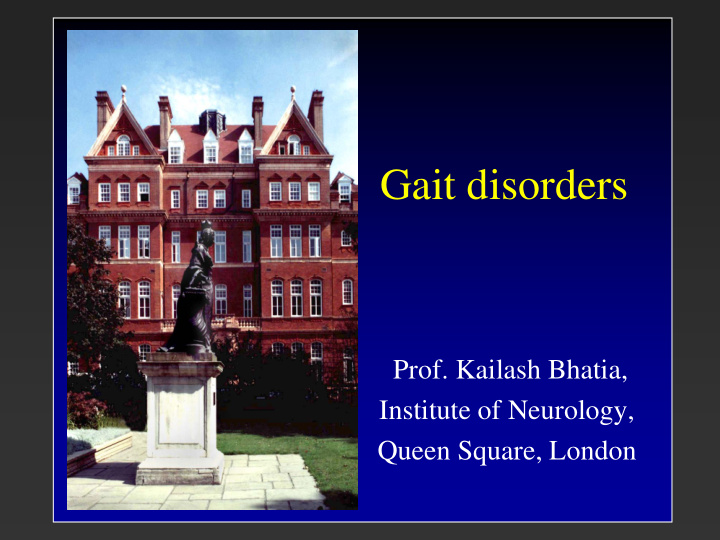



Gait disorders Prof. Kailash Bhatia, Institute of Neurology, Queen Square, London
Gait disorders can be tricky
Gait disorders are common • Abnormalities of gait and balance can be caused by peripheral &/or CNS disorders, from motor weakness & sensory loss, to loss of automaticity, cognitive decline • Consequences - fear of falling’ and need for assistive devices, resulting in social isolation and reduced activity • Falls are most common cause for injury related hospital admissions
Outline of this talk • Classification of gait disorders • Approach to a patient with gait disorder • Pathophysiology of higher order gait disorder • Examples of different forms of gait disorders • Recognition of particular forms of gait disorders • Concluding summary
Classification of gait disorders • Nervous system complexity level - lower, middle, and higher level • Anatomic lesion location (i.e. cerebellar, frontal lobe etc.) • By etiology (i.e. vascular disease, degenerative parkinsonism, spinocerebellar ataxias) • Clinical phenomenology (i.e. ataxia, parkinsonism, dyskinesia) - sub-classified as continuous or episodic
Approach in a patient with gait problem As always good history & physical and neurological exam – Most importantly - Watching the gait- stance, cadence, steppage, arm swing, postural reflexes - Look out for associated features: are there features of parkinsonian, cerebellar, spasticity, or weakness or sensory loss.
Higher level gait disorders • The term higher ‐ level gait disorders (HLGD) defines a category of balance and gait disorders that are not explained by deficits in strength, tone, sensation, or coordination. HLGD are characterized by various combinations of disequilibrium and impaired locomotion- Nutt 2013 • Various terms used gait apraxia, frontal • ataxia, marche a petits pas, lower-half parkinsonism, and many more
Etiologies of HLGD • Degenerative disorders, • Large-vessel strokes, • Microvascular disease with white matter lesions, and microinfarcts, • Tumours, • Hydrocephalus.
Characteristic features of HLGD
Mid level
Freezing and cycling
Trunkal and gait ataxia
Spastacin gene mutation gait
Some particular gait disorders
Bouncy leg gait of post anoxic myoclonus
Lordotic gait In stiff person syndrome
MdJ 2001
Video – gait is a give away
Episodic gait disorders
Man with dystonic foot – who walks backwards better then forwards
Episodic gait disorders : The dancing lady • This lady would get these episodes after walking or exerting – Marsden diagnosed her as possible functional – somatization • Later her son developed epilepsy at a young age – there was no other family history
Neurology 2020
The Criss – Cross gait is a hint to GLUT-1 deficiency
Concluding commentary • Studying gait is one of the most important aspects of the clinical examination in a movement disorders patient to help with the diagnosis and note the systems involved • Gait disorders can be classified in different forms • Important to note the associated features • Important to recognise particular forms of gaits • Management depends on the particular form but efforts to prevent falls, strengthening and balance rehabilitation is crucial
Recommend
More recommend